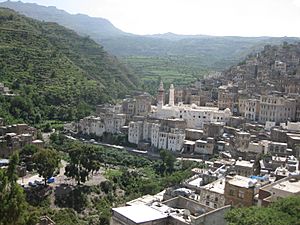Sulayhid dynasty facts for kids
Quick facts for kids
Sulayhid dynasty
بَنُو صُلَيْح
|
|||||||||||||||||
|---|---|---|---|---|---|---|---|---|---|---|---|---|---|---|---|---|---|
| 1047–1138 | |||||||||||||||||
| Capital |
|
||||||||||||||||
| Common languages | |||||||||||||||||
| Religion | Ismaili Shia Islam | ||||||||||||||||
| Government | Sultanate | ||||||||||||||||
| Sultan | |||||||||||||||||
|
• 1047–1066 (first)
|
Ali al-Sulayhi | ||||||||||||||||
|
• 1067/1081–1086
|
Al-Mukarram Ahmad | ||||||||||||||||
|
• 1086–1138
|
Arwa al-Sulayhi | ||||||||||||||||
| Historical era | Early Middle Ages | ||||||||||||||||
|
• Established
|
1047 | ||||||||||||||||
|
• Disestablished
|
1138 | ||||||||||||||||
| Currency | Dinar | ||||||||||||||||
|
|||||||||||||||||
The Sulayhid dynasty (which means "Children of Sulayh" in Arabic) was a powerful family that ruled a large part of Yemen. They were part of the Ismaili branch of Shia Islam. This dynasty was started in 1047 by a leader named Ali al-Sulayhi.
At its strongest, the Sulayhid rule brought a time of peace and wealth to Yemen. This was a period of prosperity not seen since ancient times. The Sulayhids worked closely with the Fatimid Caliphate, a big empire based in Cairo, Egypt. They were often at war with the Rassids, who were another group of rulers in Yemen. The Sulayhid dynasty ended in 1138.
Contents
Who Were the Sulayhids?
The Sulayhid family came from an Arab clan in Yemen called Banu Salouh. This clan was part of the al-Hajour tribe, which came from the Hashid tribe. The Hashid tribe was part of the larger Hamdanids group.
How the Sulayhids Rose to Power
Long before the Sulayhids, in 881, the first Ismaili teachers arrived in Yemen. This was about 30 years before the Fatimid Caliphate was even formed. These teachers spread their beliefs among the mountain tribes.
In the early 900s, one of these teachers, Ibn al-Fadl, took control of San'a and the central highlands. Another teacher, Ibn Hawshab, settled in Shibam Kawkaban. But their rule did not last. Another local family, the Yu'firid dynasty, defeated them in 916.
Even after this setback, the Fatimids continued their mission in Yemen. A Fatimid leader named Sulayman az-Zawahi became friends with a young man named Ali al-Sulayhi from the Jabal Haraz mountains. Ali was the son of a respected leader from a different Islamic group (Sunni Islam). But he was open to the Fatimids' ideas.
In 1046, Ali became an Ismaili and was given an important role in spreading the faith. In 1047, he gathered an army in Haraz. This was the start of the Sulayhid dynasty.
Ali al-Sulayhi's Conquests
Over the next few years, Ali al-Sulayhi's army took control of all of Yemen.
- In 1060, he took Zabid, the capital of the Najahids.
- By 1062, he had conquered all of Yemen.
- He then moved north and took control of the Hejaz region, which includes Mecca. For a while, the Sulayhids even chose the leaders of Mecca.
- In 1063, Ali took control of San'a after fighting the Zaidiyyah group. He made San'a the capital of his kingdom.
- The Ma'nids of Aden were defeated in 1062 and had to pay tribute to the Sulayhids.
Ali al-Sulayhi appointed governors to rule different parts of his kingdom.
Al-Mukarram Ahmad's Reign
Ali al-Sulayhi was killed by relatives of the Najahids, whom he had defeated earlier. This happened in either 1067 or 1081. His son, Al-Mukarram Ahmad, became the next ruler.
At the start of his rule, the Sulayhid kingdom became much smaller, possibly only controlling the San'a area. After some time, Al-Mukarram Ahmad rescued his mother, Asma bint Shihab, who had been captured by the Najahids. The Sulayhid armies then won back a lot of land.
Even though the Najahids remained powerful in some areas, the Sulayhids were still the strongest rulers in Yemen. In 1083, another Ismaili family, the Zurayids, came to power in Aden. They were at first under Sulayhid rule.
Al-Mukarram Ahmad's rule ended in 1086. He handed over power to his wife, Arwa al-Sulayhi. He might have still had some influence for a few years. He passed away in 1091.
Queen Arwa, a Great Ruler

Arwa al-Sulayhi ruled from 1086 to 1138. She had four children with Al-Mukarram Ahmad, but none of them became active in politics. The Fatimid leaders in Egypt recognized Queen Arwa as the main ruler over the different kings in Yemen.
Around 1087, she moved her capital from San'a to Jibla. Queen Arwa was known as an amazing ruler. She is considered one of the most famous ruling queens in Islamic history. She governed with the help of several strong assistants.
Queen Arwa's Assistants
- Her first assistant was Saba' bin Ahmad. He was a distant cousin of the Sulayhids and formally married Queen Arwa. However, their marriage was likely just for political reasons. He fought hard against the Najahids and died in 1098. After his death, San'a was lost to the Sulayhids.
- Her second assistant was Al-Mufaddal bin Abi'l-Barakat. He ruled from at-Ta'kar, a large mountain fortress near Jibla. He also fought against the Najahids. He died in 1111.
- Her third assistant was Ibn Najib ad-Dawla. He arrived in Yemen in 1119 from Egypt, sent by the Fatimid caliph. He helped bring peace to much of southern Yemen and pushed back the Najahids. In 1125, he tried to take power because he thought the queen was too old to rule. But he failed and was sent back to Egypt in a wooden cage, dying on the way.
The last years of Queen Arwa's rule are not well-known. When she died in 1138, there were no other family members left to rule. This brought the Sulayhid era to an end.
Sulayhid Rulers
- Ali al-Sulayhi (1047–1067 or 1081)
- Al-Mukarram Ahmad (1067 or 1081–1086)
- Arwa bint Ahmad (1086–1138)

